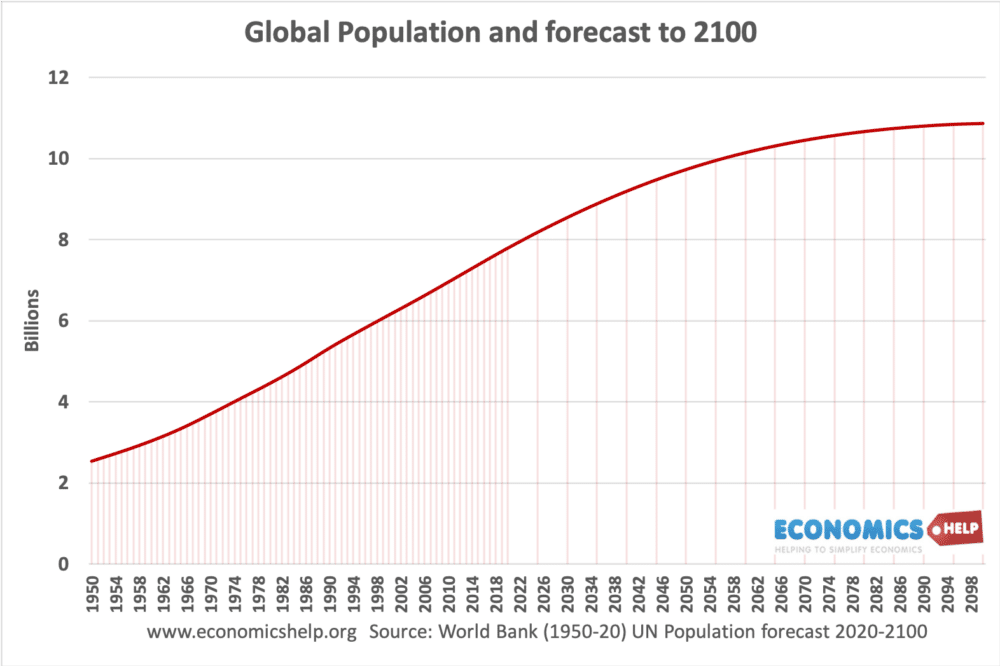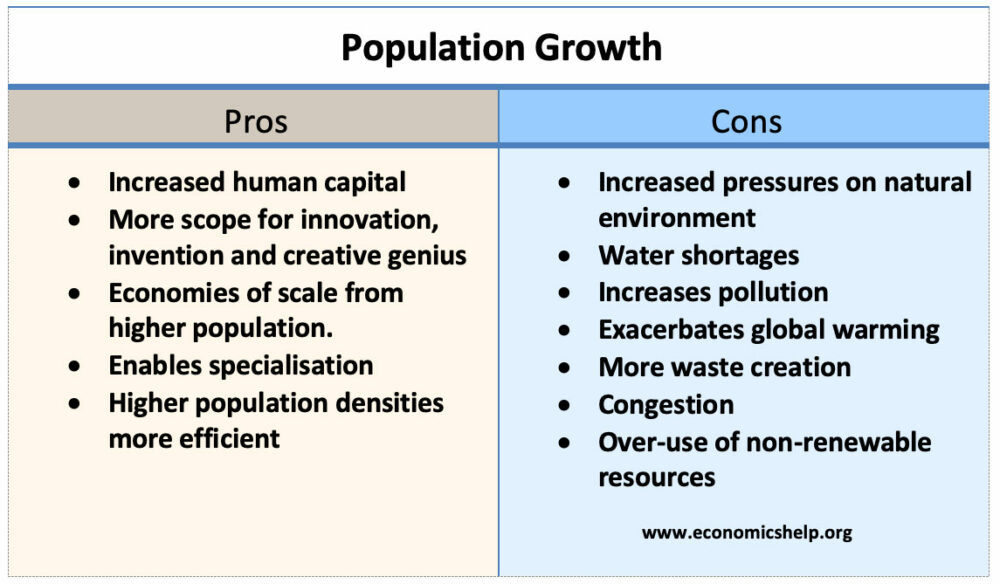Over the course of history, the world has seen rapid population growth. It has enabled a rich diversity of culture, technology and improved living standards. However, population growth is increasingly coming at a cost – in particular to the environment. High population levels are contributing to the depletion of natural resources and causing widespread pollution. Some fear population growth is now deeply damaging for both the planet and even the survival of many natural habitats. However, others argue that fears other population growth are misplaced with the planet having room for more people, so long as we learn to live more in harmony with nature and more efficiently in big cities.
Advantages of population growth
1. More people leads to greater human capital. If there are more people, the probability of finding a genius like Einsterin, Marie Curie, Beethoven increase. These exceptional people can lead to technological and cultural masterpieces which enrich our lives. The past 200 years have shown exponential growth in technical development and innovation. There are many factors behind this, but the world’s growing population means we have a bigger pool of human capital and the possibility of these cutting edge discoveries increase.
2. Higher economic growth. Population growth will lead to economic growth with more people able to produce more goods. It will lead to higher tax revenues which can be spent on public goods, such as health care and environmental projects.
- The obvious evaluation is to say, the crucial thing is not GDP, but GDP per capita. If economic growth is at the same rate as population growth, average living standards will not increase. However, it is possible population growth can also improve per capita incomes. As the population increases, the economy can benefit from a bigger talent pool, economies of scale and greater specialisation. All this can enable higher per capita income, which we have seen in major developed economies.
3. Economies of scale. Farming and industry have been able to benefit from economies of scale, which means as the population grows, food output and manufacturing output have been able to grow even faster than population growth. For example, at the turn of the nineteenth century, Thomas Malthus predicted population growth would lead to famine as we would be unable to feed the growing population. However, his dire predictions failed to materialise because he failed to understand, that the productivity of land, labour and capital could all increase more than proportionately. 300 years ago, most of the population worked on the land. Technological innovation and economies of scale, mean productivity of land has vastly increased as farmers make use of mechanisation and economies of scale for increased food production.
4. The efficiency of higher population density. In terms of per capita carbon footprint, areas with a high population density are significantly more efficient than rural areas and places with a low population. When people live in densely populated areas, they are more likely to use public transport, live in apartment buildings which are easier to heat. In big cities, transport and the delivery of goods is much more efficient, whereas for low population densities, the average cost and environmental footprint are much higher. Therefore, population growth which leads to growth in city connurbations (which is a feature of global growth in past) is not as environmentally damaging as we may think. In Green Metropolis, by David Owen he argues living in closer proximity in cities is a key aspect of sustainability
- Urban areas account for only 3% of the world’s land surface. But, more than 50% of the population. By 2050, the United Nations predict this will rise to 70%. Therefore, population growth doesn’t have to lead to an equivalent fall in natural habitats.
5. The improved demographic structure of society. Many western economies are now experiencing a falling population, with the result that their population demographic is being skewed to old, retired people. This is imposing costs on society as we struggle to pay for health care and pensions. Moderate population growth helps to rebalance the population with a higher share of young, working people.
6. Critical mass. Higher populations can enable a critical mass of people to enable a sider, more vibrant society. With low populations, there is less scope for diversity. But, when the population grows, it can enable the support of a broader cultural range of activities.
Disadvantages of population growth
1. Cost to the environment. Population growth exacerbates many of the existing environmental problems
- Trying to reduce carbon and methane emissions to reduce global warming is relatively more difficult as the population.
- There will be greater threat on natural habitats as a greater population has greater demand for housing and farmland. This will increase pressure to cut down forests to make way for farming and housing.
- Higher population will lead to a greater consumption of non-renewable resources, leading to a faster depletion of natural resources.
- Higher population will lead to greater pollution levels in air, water and land. Higher pollution is associated with a range of health issues, such as cancer and asthma. The pollution also harms animals and plants.
- Soil degradation. To feed a growing planet, we have seen serious degrading of farmland (according to UN estimates) about 12 million hectares of farmland every year. This is due to factors, such as overgrazing, use of chemicals, climate change and use of chemicals.
2. Congestion. Too many people in a small space will lead to various types of congestion. Road congestion is a major problem across the world. One study suggested congestion cost the EU €111bn (1% of GDP) in 2012. WIth population growth, the costs of congestion will only increase leading to time lost, more pollution and lost output.
3. Water shortages. Already up to 40% of the world’s population face water scarcity and the risk of drought. According to the UN water shortages could lead to 700 million people at the risk of displacement. A growing population will put pressure on scarce water supplies and this is a factor behind many minor and major conflicts with countries having to find ways around the shortage of water.
4. Generating unsustainable waste. We are currently generating non-biodegradable rubbish that we are struggling to process. It tends to end in landfill, causing methane emissions and other toxic problems.

Related


very much helpful
i agree with this statement as poulation increae = gods bible
very helpful
thank you very helpful
That’s much appreciating. Its indeed a wonderful differentiation 👏.
wow amazing I feel like this should be global
Wow,this will enable students learn more
All I want to say is thank u for presenting this minor topic so efficiently:)
Thx 🙏 4 the help we really appreciate.Student
Am really thankful for d
Answers
Of course!
I enjoyed reading your article on the pros and cons of population growth. It was well-written and informative.
I agree with your points about the potential benefits of population growth, such as increased economic growth and innovation. However, I also think it’s important to be aware of the potential challenges, such as increased pressure on resources and the environment.
I think it’s important to find a balance between the benefits and challenges of population growth. We need to find ways to ensure that population growth is sustainable and that it doesn’t lead to negative consequences for the environment or society.
For more information on population growth, I recommend checking out Exam Notes. The website has a wealth of information on the topic, including articles, blog posts, and videos.
Good, very clear and easy to understand
This was so good of importance to my studies.
thank you.
Very good thank you